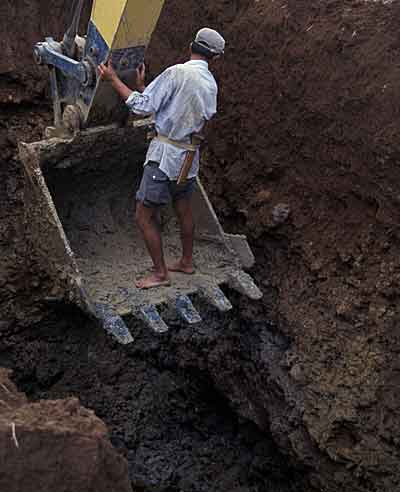Post by Laoupdate on Mar 25, 2005 21:35:33 GMT -5

Digging in the dirt at LaosEHuay Xai sapphire mine. Photo: © R.W. Hughes
SINGAPORE: Two Australian-owned projects to produce gold and copper in Laos will pave the way for other foreign companies to mine the Southeast Asian country, a senior government official said on Thursday.
Nam Viyaketh, vice minister of industry and handicrafts, said more than 50 domestic and international companies were looking for minerals such as copper, zinc and iron ore in Laos, where mining is in its infancy.
“Our hands are full with letters of intent,EViyaketh told Reuters. “We will sign them as soon as possible, but we want to know first which companies are really interested in long-term investment.EAustralia’s Oxiana Ltd. started mining gold in southern Laos in 2003 and last week began copper production at its plant 600 km (375 miles) southeast of the capital, Vientiane.
“There’s been a boom in the mining sector in Laos since 2003. Before, it was a sleeping sector,EViyaketh said on the sidelines of the 2005 Asian Mining Congress. Pan Australian Resources will become the country’s second producer when it pours the first gold from its Phu Bia project northeast of Vientiane in early May.
“Companies didn’t want to invest before, as there was too much risk. But now they’ve seen it can be a success, and they believe they can be successful too,EViyaketh said. Strong metals prices have also helped: copper traded at its record high last week and gold prices struck a 16-1/2-year peak in December.
Potash and iron ore: Viyaketh said the next big development would be a Chinese-owned potash mine that could produce 1 million tonnes a year of the mineral used in fertilisers.
He said several companies from China and Vietnam Esome with backing from North America and Europe Ehad applied for licences to start exploring two large iron ore deposits, one in the north of the country and the other in the south.
The world’s top miners of iron ore, used to make steel, won a 71.5 percent increase in 2005 contract prices as China’s enormous demand for industrial metals sucked in more of the raw material. China, which borders Laos to the north, imported 40 percent more iron ore last year and will consume about one-third of the world’s seaborne ore in 2005.
“We’ve encouraged exploration in iron ore, but we’re not sure of the size of our mines,EViyaketh said. He said only 26 percent of Laos had been geologically mapped, but estimated the entire country had about 500 properties. “Based on these data, foreign companies are following up and getting memoranda of understanding to start exploration.E
Mining a priority: Mining accounts for about one-third of the country’s industrial earnings, which in turn contribute 26 percent of gross domestic product, Viyaketh said.
Officials attending the conference said the Oxiana and Pan Australian projects together would account for well over 10 percent of GDP when both were running at full capacity. Gary Stafford, managing director of Pan Australian, said: “Having clear legislation, clear fiscal benefits to the government laid out are the sort of things directors need to see before they can make an investment decision.E—Reuters
Source: www.dailytimes.com.pk/default.asp?page=story_26-3-2005_pg5_17
Photo: www.ruby-sapphire.com/lao_sapphires.htm
